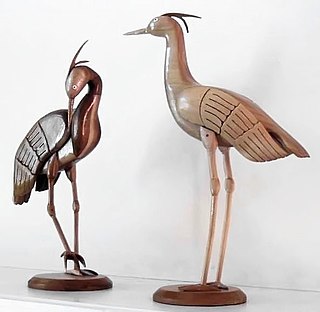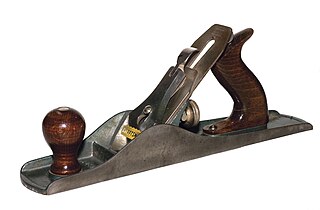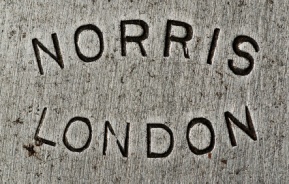Critical reception
The book has been widely acclaimed in both the general and specialized press. According to the Sheffield Telegraph , "the book not only celebrates the collection but is considered the most serious work of reference of its kind to date and destined to become a 'bible' in its field". [3] Looking at the book from another angle, Eve Kahn in The New York Times stated that the book was "intended to glamorize unsung innovations". [4] Carl Duguay, writing in Canadian Woodworking & Home Improvement, declared that the book was "Lavish, stunning, outstanding, magnificent ... superlatives just don't do justice to [it]." [5]
Journals of some of the leading tool societies have been generous in their praise. "David Russell’s book is a vehicle for sharing his fabulous collection with the world," enthused John Wells in the Chronicle, the journal of the Early American Industries Association. "His unerring eye has sought out the most interesting tools available over the past 40 years, resulting in one of the world’s greatest collections of antique woodworking tools." [6] The late Frank Ham, writing in the Australian journal Tool Chest, declared the book to be "the most impressive record of tools" he had ever seen. [7]
Focusing on the illustrations, Mark Bridge commented in Antiques Trade Gazette on how James Austin, the book's photographer, had "managed to capture the elusive qualities of balance, texture and patina which make the finest tools a pleasure to handle, frequently lifting them into the realm of folk art". [8]

Woodworking is the skill of making items from wood, and includes cabinet making, wood carving, joinery, carpentry, and woodturning.

The hobby of collecting includes seeking, locating, acquiring, organizing, cataloging, displaying, storing, and maintaining items that are of interest to an individual collector. Collections differ in a wide variety of respects, most obviously in the nature and scope of the objects contained, but also in purpose, presentation, and so forth. The range of possible subjects for a collection is practically unlimited, and collectors have realised a vast number of these possibilities in practice, although some are much more popular than others.

A hand tool is any tool that is powered by hand rather than a motor. Categories of hand tools include wrenches, pliers, cutters, files, striking tools, struck or hammered tools, screwdrivers, vises, clamps, snips, hacksaws, drills, and knives.

A smoothing plane or smooth plane is a type of bench plane used in woodworking. The smoothing plane is typically the last plane used on a wood surface, removing very fine shavings to leave a smooth finish. When used effectively it quickly produces a finish that equals or surpasses that made by sandpaper.

A hand plane is a tool for shaping wood using muscle power to force the cutting blade over the wood surface. Some rotary power planers are motorized power tools used for the same types of larger tasks, but are unsuitable for fine-scale planing, where a miniature hand plane is used.

A spokeshave is a hand tool used to shape and smooth woods in woodworking jobs such as making cart wheel spokes, chair legs, paddles, bows, and arrows. The tool consists of a blade fixed into the body of the tool, which has a handle for each hand. Historically, a spokeshave was made with a wooden body and metal cutting blade. With industrialization metal bodies displaced wood in mass-produced tools. Being a small tool, spokeshaves are not suited to working large surfaces.

A jack plane is a general-purpose woodworking bench plane, used for dressing timber down to size in preparation for truing and/or edge jointing. It is usually the first plane used on rough stock, but for rougher work it can be preceded by the scrub plane. The versality of the jack plane has led to it being the most common bench plane in use. The name jack plane is sometimes used interchangeably with the longer fore plane.
Lie-Nielsen Toolworks, Inc. is a family-owned business, established in 1981 and based in Warren, Maine. It manufactures a range of high quality hand tools, primarily for woodworking, based on traditional designs. It is best known for its hand planes. Thomas Lie-Nielsen is the founder and CEO of Lie-Nielsen Toolworks.
Although an antique tool might be said to be one that is more than a hundred years old, the term is often used to describe any old tool of quality that might be deemed collectable.
The Holtzapffel dynasty of tool and lathe makers was founded in Long Acre, London by a Strasbourg-born turner, Jean-Jacques Holtzapffel, in 1794. The firm specialized in lathes for ornamental turning but also made a name for its high-quality edge and boring tools.
Bedrock is a design of bench planes developed by Stanley Works as an improvement over the Bailey plane design. It was introduced in the early 20th century.

Thomas J. Duffy is a designer/craftsman whose present work is the conceptualization and creation of curved doors using lasers. Duffy has also crafted one-of-a-kind cabinets, chairs, and other furniture. For many years, Duffy also made St. Lawrence River rowing skiffs. One of his furniture works is in the permanent collection of the Boston Museum of Fine Arts. He has exhibited at numerous galleries and other venues. The New York Times described him as “One of this country’s leading cabinet and chair makers..."
Edward Preston & Sons is a tool manufacturer based in Birmingham, England.
George Bacchus & Sons, originally called Bacchus & Green was a 19th-century manufacturer of fine glassware located in Birmingham, England.

David R. Russell was a builder who for many years collected antique woodworking tools.
John Adamson is a British publisher, translator and writer. He specialises in illustrated books in the fine and decorative arts.
The firm of Alexander Mathieson & Sons was one of the leading makers of hand tools in Scotland. Its success went hand in hand with the growth of the shipbuilding industries on the Firth of Clyde in the nineteenth century and the emergence of Glasgow as the "second city of the Empire". It also reflected the firm's skill in responding to an unprecedented demand for quality tools by shipyards, cooperages and other industries, both locally and far and wide.

The firm of T. Norris & Son was one of the most prestigious makers of hand tools in England in the late nineteenth and early twentieth centuries and famed for the quality and gracefulness of its output, notably of its metal planes. Both wooden and metal planes made in Norris's workshop survive as do other edge tools. Some Norris planes, especially bespoke models, are highly prized by woodworkers and collectors.

James Austin is an Australian fine-art and architectural photographer.
Stewart Spiers was a small but innovative firm of plane-makers in Scotland, founded first of all in Ayr in Ayrshire and continuing under the registered name of Stewart Speirs Ltd [sic] in Paisley, Renfrewshire, from c. 1933 until its demise in the mid to late 1930s. Like the Glasgow firm of Alexander Mathieson & Sons, Spiers benefited hugely from the thriving industries on the Firth of Clyde in the latter half of the nineteenth century.











